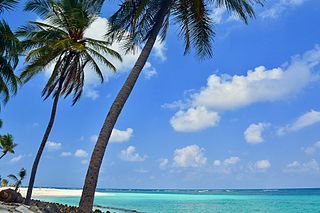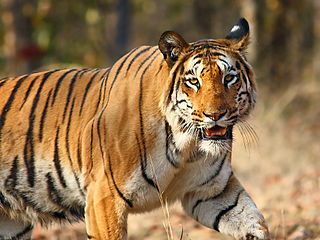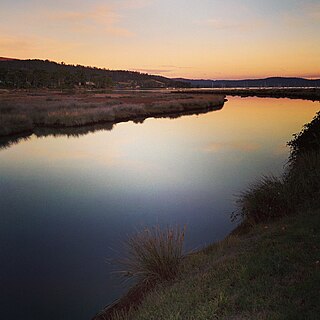Related Research Articles

Michaelmas and Upolu Cays is a national park in Queensland, Australia, 1,409 km (876 mi) northwest of Brisbane and 33 km (21 mi) east of Cairns. It comprises two small cays on Michaelmas Reef, which forms the north-eastern section of the Arlington reef complex, within the Great Barrier Reef.

The Sandwich tern is a tern in the family Laridae. It is very closely related to the lesser crested tern, Chinese crested tern, Cabot's tern, and elegant tern and has been known to interbreed with the lesser crested. It breeds in the Palearctic from Europe to the Caspian Sea wintering to S Africa, India and Sri Lanka

The lesser crested tern is a tern in the family, Laridae.

The greater crested tern, also called crested tern or swift tern, is a tern in the family Laridae that nests in dense colonies on coastlines and islands in the tropical and subtropical Old World. Its five subspecies breed in the area from South Africa around the Indian Ocean to the central Pacific and Australia, all populations dispersing widely from the breeding range after nesting. This large tern is closely related to the royal and lesser crested terns, but can be distinguished by its size and bill colour.

The Laccadive Sea or Lakshadweep Sea is a body of water bordering India, the Maldives, and Sri Lanka. It is located to the southwest of Karnataka, to the west of Kerala and to the south of Tamil Nadu. This warm sea has a stable water temperature through the year and is rich in marine life, the Gulf of Mannar alone hosting about 3,600 species. Mangaluru, Kannur, Kozhikode, Kochi, Kollam, Thiruvananthapuram, Tuticorin, Colombo, and Malé are the major cities on the shore of the Laccadive Sea. Kanyakumari, the southernmost tip of peninsular India, also borders this sea.

Lakshadweep, formerly known as the Laccadive, Minicoy and Aminidivi Islands, is a group of islands in the Laccadive Sea, 200 to 440 km off the southwestern coast of India. The archipelago is administered as a union territory and district of India. They were also known as Laccadive Islands, although geographically this is only the name of the central subgroup of the group. Lakshadweep means "one hundred thousand islands" in Malayalam, Kannada, Telugu and Tamil. The islands form the smallest Union Territory of India and their total surface area is just 32 km2 (12 sq mi). The lagoon area covers about 4,200 km2 (1,600 sq mi), the territorial waters area 20,000 km2 (7,700 sq mi) and the exclusive economic zone area 400,000 km2 (150,000 sq mi). The region forms a single Indian district with 10 subdivisions. Kavaratti serves as the capital of the Union Territory and the region comes under the jurisdiction of Kerala High Court. The islands are the northernmost of the Lakshadweep-Maldives-Chagos group of islands, which are the tops of a vast undersea mountain range, the Chagos-Laccadive Ridge.

The brown noddy or common noddy is a seabird in the family Laridae. The largest of the noddies, it can be told from the closely related black noddy by its larger size and plumage, which is dark brown rather than black. The brown noddy is a tropical seabird with a worldwide distribution, ranging from Hawaii to the Tuamotu Archipelago and Australia in the Pacific Ocean, from the Red Sea to the Seychelles and Australia in the Indian Ocean and in the Caribbean to Tristan da Cunha in the Atlantic Ocean. The brown noddy is colonial, usually nesting on elevated situations on cliffs or in short trees or shrubs. It only occasionally nests on the ground. A single egg is laid by the female of a pair each breeding season. In India the brown noddy is protected in the PM Sayeed Marine Birds Conservation Reserve.

Conservation reserves and community reserves in India are terms denoting protected areas of India which typically act as buffer zones to or connectors and migration corridors between established national parks, wildlife sanctuaries and reserved and protected forests of India. Such areas are designated as conservation areas if they are uninhabited and completely owned by the Government of India but used for subsistence by communities, and community areas if part of the lands are privately owned. Administration of such reserves would be through local people and local agencies like the gram panchayat, as in the case of communal forests.

India is home to a large variety of animals. It is a biodiversity hotspot with its various ecosystems ranging from the Himalayas in the north to the evergreen rain-forests in the south, the desert sands of the west to the marshy mangroves of the east. India, lying within the Indomalayan realm, is home to about 7.6% of mammal, 14.7% of amphibian, 6% of bird, 6.2% of reptilian, and 6.0% of flowering plant species. India's forest lands nurture about 500 species of mammals and 2000+ bird species. This richness of Indian wildlife has been celebrated since time immemorial. Four of India’s national symbols consist India’s mammals.

The Fitzroy Islands comprise a group of four rocky islets that lie within the upper reaches of Payne Bay in Port Davey, an oceanic inlet, located in the south west region of Tasmania, Australia. The islands have a combined area of approximately 0.18 hectares and are contained with the Southwest National Park, part of the Tasmanian Wilderness World Heritage Site and the Port Davey/Bathurst Harbour Marine Nature Reserve.

The Sir Joseph Banks Group is an archipelago in the Australian state of South Australia located in Spencer Gulf about 20 kilometres (12 mi) off the eastern coast of the Eyre Peninsula. It consists of 21 islands of which eighteen are in the Sir Joseph Banks Group Conservation Park while the surrounding waters are in the Sir Joseph Banks Group Marine Park. It is considered to be an important seabird breeding site.

Byramgore Reef, also known as Chereapani Reef, is a coral atoll belonging to the Amindivi Subgroup of islands of the Union Territory of Lakshadweep, India. It has a distance of 1,940 km (1,210 mi) south of the city of Delhi.

Pitti, also known as Pakshipitti, is an uninhabited coral islet in the Union Territory of Lakshadweep, India.

West Island Conservation Park is a protected area occupying both West Island and Seal Island in coastal waters near Victor Harbor in South Australia. The park was proclaimed in 1972 following the enactment of the National Parks and Wildlife Act 1972 with the protection initially applying to West Island only which itself previously had reserve status under the Fauna Conservation Act 1964-1965. Seal Island was added to the park in 1979. The purpose of the park is to protect the breeding populations of bird species present on both islands such as little penguins, silver gulls, crested terns, Caspian terns and fairy terns. The conservation park is classified as an IUCN Category Ia protected area. In 1982, it was listed on the now-defunct Register of the National Estate.

Greenly Island is an island in the Australian state of South Australia located in the Great Australian Bight about 30 kilometres (19 mi) west-south-west of Point Whidbey on Eyre Peninsula. The island is uninhabited by humans and provides a haven for marine and terrestrial wildlife. The island and its intertidal zone constitute the Greenly Island Conservation Park. Its adjacent waters are occasionally visited by fishermen targeting yellowtail kingfish.

Cap Island Conservation Park is a protected area in the Australian state of South Australia located about 7.5 kilometres (4.7 mi) offshore, west of Mount Misery, Eyre Peninsula. The park covers Cap Island's 8ha surface. The island consists of a granite base and a calcarenite mantle; its margins steeply over-hanging and eroded. Typical vegetation is a low Nitre Bush shrubland. Cap Island Conservation Park was constituted by statute in 1972 to conserve a sea bird breeding area and Australian Sea-lion and New Zealand Fur-seal haul-out areas.

The Port Cygnet Conservation Area is located in Cygnet, Tasmania, approximately 65 km (40 mi) southwest of the state's capital city, Hobart. The reserve has an area of 103 ha. It is an open estuary environment including a listed wetland of state significance, being the only Marine Protected Area (MPA) in the Bruny Bioregion representing the Open Estuaries Biounit.
The Cartier Island Marine Park is an Australian marine park that covers the Cartier Island and reef surrounds, about 610 km (380 mi) north of Broome, Western Australia. The marine park covers an area of 172 km2 (66 sq mi) and is assigned IUCN category Ia. It is one of the 13 parks managed under the North-west Marine Parks Network.
The Ashmore Reef Marine Park is an Australian marine park that covers the Ashmore Reef, which is located about 630 km (390 mi) north of Broome and 110 km (68 mi) south of the Indonesian island of Rote. The marine park covers an area of 583 km2 (225 sq mi) and is assigned IUCN category Ia. It is one of 13 parks managed under the North-west Marine Parks Network.
Dr KK Mohammed Koya Sea Cucumber Conservation Reserve is the first sea cucumber conservation area in the world. It is located in the Cheriyapani Reef in the Indian Union Territory of Lakshadweep. It was formed in 2020. It covers an area of 239 km2.
References
- 1 2 Badri Chatterjee (29 February 2020). "World's first sea cucumber conservation area in Lakshadweep". Hindustan Times. Retrieved 23 July 2020.
- ↑ KA Shaji (13 May 2020). "Lakshadweep gets world's first sea cucumber conservation reserve to curb smuggling into China". Scroll. Retrieved 23 July 2020.
| This article about protected areas of India is a stub. You can help Wikipedia by expanding it. |